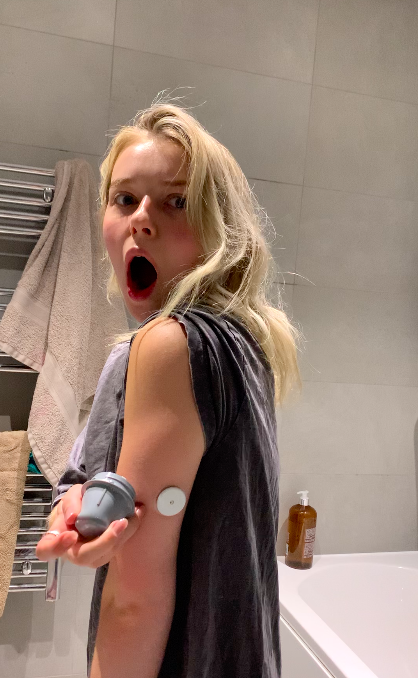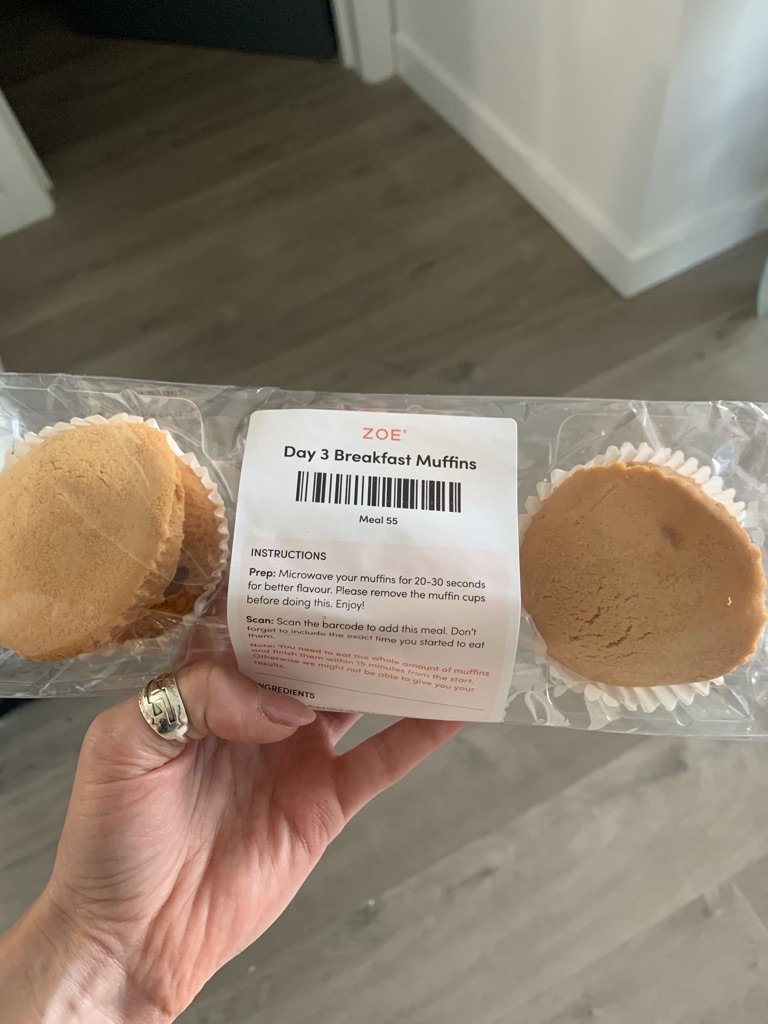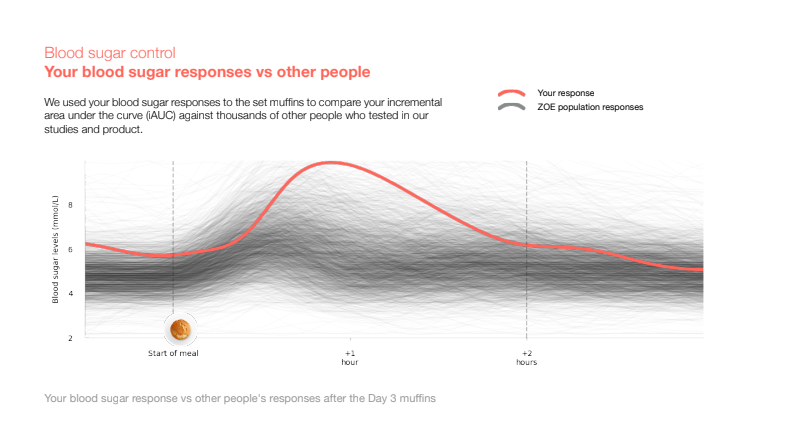Have you always wanted to learn more about your body? Or been curious to know the state of your gut health? Writer Chloe Gray took part in huge study by Zoe to find out more about her body – and received a few surprises.
How far would you be willing to go to test your health? That’s not a rhetorical question, but one we should all start seriously thinking about as new, invasive products that allow us to get up close and personal with our bodies become more accessible.
I realised that I’m prepared to go quite far to discover the inner workings of my biology when I found myself applying a blood sugar device to my arm on a Sunday morning. The vacuum-sealed needle that would live in my arm for two weeks was just the beginning of my journey on a personalised nutrition plan by a company called Zoe.
Already a huge success in America, Zoe’s plan has recently launched in the UK with a 250,000-person waiting list. But what is it about the plan that got me – someone who squeals during blood tests – to jump at the chance of wearing a sensor for a fortnight. And crucially, did I learn anything important?
What is Zoe, and what happens during the Zoe plan?
As the health world has come to realise that a one-size-fits-all approach doesn’t work, more and more programmes are being designed to give personalised, tailored health advice. Zoe is just one of them.
It’s the brainchild of professor Tim Spector from the genetic epidemiology department at King’s College London. As the head of a well-known twins study, he realised that despite twins having identical genetics, the way they react to food was completely different. That opened the gates for him to want to discover how personal biology impacts our metabolism and gut health.
Health is becoming increasingly personalised
In a world where headlines often enforce static rules about health and wellbeing (‘low carb is best’, ‘we should all be intermittent fasting’), Zoe is designed to test and track individual biology to give you a unique template for the kinds of foods that best serve your body. It’s also a scientific study, with participants’ data being used in the largest in-depth nutrition study in the world to improve not only individual health but build a better understanding of nutrition for the collective. The group previously found from its research into 953 participants that an earlier bedtime is associated with healthier blood glucose levels.
That message got me hooked. I’ve long believed that health is personal and there is no single best route to looking after our bodies. But before Zoe, accumulating data on how our bodies were working on the inside was virtually impossible. The idea behind Zoe is that we can all have access to data to see how our body really thrives.
The Zoe programme: how it works out the best diet for you
Testing blood sugar
It begins with the blood sugar sensor that links to an app which tracks your glucose response all day and night. This is a tool usually used by people with type 1 diabetes, and I feel conflicted over using a system designed to keep people alive for my own nosiness. Nevertheless, I watch closely as my sugar levels peak and fall around mealtimes.
Checking the gut microbiome
On the second day of the test, you take a stool sample and send it off to the lab. This is to see what kinds of bacteria are busy making a home in your gut. Lots of other home-testing kits will also check your microbiome composition, but doing it alongside the other Zoe tests gives the results more context and makes it more affordable, as isolated stool tests can easily cost three figures.
Understanding how you handle carbs, protein and fats
There are more tests on days three and four, but these are slightly more unusual. Zoe supplies you with three packs of muffins – not blueberry-flavoured numbers from Pret sadly, but rather plain cakes made to contain a specific profile of carbs, fats and proteins to see how your body reacts to different macronutrients.

You can’t eat or drink anything other than water, black coffee and tea before eating the first pack of muffins. There are three yellow sponges in the box, and they need to be eaten within 15 minutes. It’s not usually a feat for me to eat a meal that fast, but it was a lot for 9am, especially given that they tasted extremely sugary, quite claggy and very dry.
You fast for four hours after your breakfast before having the lunch muffins – they’re slightly lighter but still dry and hard to eat. After fasting for another two hours, you take a finger prick test, dropping your blood onto a small piece of testing paper provided by Zoe. If you’re a needle-phobe like me, you’ll have to get your partner or friend to push the pellet into your skin to draw blood.
While your blood sugar sensor is monitoring your reaction to carbohydrates the whole time, the blood test will check your response to the fats in the muffins. When that’s done, you can eat and drink like normal – until the next morning. Another fast and a pack of muffins for breakfast and finally the muffin challenge is done.
There’s about a week or so left with the sensor in your arm, and in that time, you can use the Zoe app to track your meals for a more in-depth picture of how you react to food (if tracking feels triggering, you can skip this part). The app is also full of lessons that take just a few minutes to complete on subjects from what the microbiome is to the importance of different food groups.

The results
Is it weird to say I was extremely nervous about opening the email that arrived a few weeks later containing my results? It felt exposing – like my insides were on the page.
In a way, they were: the document details the exact quantity of every single important bacteria, good and bad, in your gut and scores your microbiome in comparison to other people of your age and sex.
My gut scored 82, deemed ‘good’, and it felt like receiving an A on an exam. But as all perfectionists do, I berated myself for losing points, including not having the beneficial parasite Blastocystis in my gut. According to a study published in the journal Microorganisms, this bacteria is correlated with high bacterial diversity, while a 2020 study found it was associated with an improved metabolism.
My blood fat response was also ‘good’. That means I can clear fat from my body well, with better blood fat control linked to reduced dietary inflammation. Before Zoe, I had long suspected my body thrived on high-fat foods, given I often gravitate towards things like eggs, nuts, dark chocolate and avocado.
But the smugness faded when I saw my blood sugar control results. Despite being very active and generally healthy, I scored a very low 23, which put me in the ‘bad’ category. As I read other women my age tended to score between 52 and 88, I panicked.
My blood sugar chart showed my glucose levels spiking slower, higher and for longer than the average person. That matters because having frequent and large spikes of blood sugar can lead to inflammation, poor energy, excessive hunger and eventually diabetes and heart disease, according to a 2021 paper published in the American Journal of Clinical Nutrition and based on research by Zoe.
What influences how well we metabolise carbs or sugar?
Sex and age
I ask Dr Sarah Berry, head of nutrition at Zoe, what this means for me. “There are so many different factors that impact how our body responds to carbohydrates. While you can’t change some things, like your age or your sex, there are contextual factors that can modify your response,” she says.
Time of day
Studies also suggest the time of day you eat can influence blood sugar, with morning carbohydrates thought to have less of an impact on blood sugar levels. A bad night’s sleep can also worsen blood sugar control while exercising after eating carbohydrates can reduce their impact.
What you eat carbs with
“You can also dampen the spike by pairing up different foods. If you add a protein or fat, for example, it can counterbalance some of the inflammation that occurs after eating carbohydrates to have a favourable impact on your health. Polyphenols, which are bioactive nutrients found in a whole host of red and dark pigmented foods, also reduce your blood sugar responses,” Dr Berry adds. I’m relieved that she doesn’t tell me to cut out carbs altogether (in fact, she passionately advises against trying diets like keto).

Genetics
I’m still worried about why my score is so low, and if there’s anything I’ve done to cause that. “Much of your blood sugar response is due to genetics,” reminds Dr Berry. “But know that you’re not a hostage to that response. Modifying your meals and lifestyle can minimise your blood sugar response and the damage of those spikes.”
Once I’ve got over the shock, I turn to the app. Now I’m in Zoe 2.0, the second phase of the plan where I have a library of foods and recipes all ranked specifically for me.
For example, a banana is an amber score of 42 – gaining points for its good impact on my gut health but losing them due to fast-acting carbs that are not great for my blood sugar. When I pair it with some peanut butter (79) and wholegrain toast (50), my breakfast moves into the green, giving a score of 57. For someone else, a banana might be a solid 100, or a lower 20, depending on how their body processes carbs and fats. The idea is that you balance out the red foods (eat once in a while), the amber (have in moderation) and the green (enjoy regularly) for a balanced day.
Is nutritional testing worth the faff, or just another way to monitor our diets?
I love this approach to nutrition. The ability to see how you react to specific foods really strips away society’s message of what is ‘healthy’. Many so-called ‘good’ foods are ‘red’ for me in the app, while it turns out that many things deemed ‘unhealthy’ are things I should actually be eating in abundance.
I’m enjoying piecing foods together like a jigsaw for a plate my body will thrive on. And this approach proves that adding foods, rather than restricting them, is the optimum route for health. It also takes the focus off of calories and onto nutrients. Adding olive oil to my pasta now puts me in the green, unlike other food tracking apps where it may have flagged that I was simply adding extra calories.
It’s not ideal for anyone to be tracking their food all of the time, particularly if you’re prone to anxiety or obsession around your diet. I used the app for a few days to get the idea, and now I try to let my intuition and knowledge about food guide me. If I’m trying something new, I might turn to the app with curiosity, but I don’t want to let it rule me.
Is the Zoe programme worth the price?
Zoe is an investment, priced at £259.99 for the test and results, or £299.88 for the test and 12-month app access (or £24.99 a month). But compared to other tests that offer less information and scientific backing, I don’t think it’s unreasonable.
While having this granular detail about yourself isn’t necessary for you to be healthy, I can’t argue that it’s been eye-opening. I have learned an important lesson about myself that I wouldn’t have otherwise known. I also love that I’m now playing my part in a global nutrition study, but that might put some people off.
Let’s be honest – wearing a sensor designed for people with a disease and going through all of these invasive tests is an extreme way to monitor your health. But for me, these huge lengths have paid off.
Images: author’s own; Getty
Source: Read Full Article
